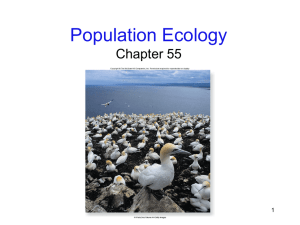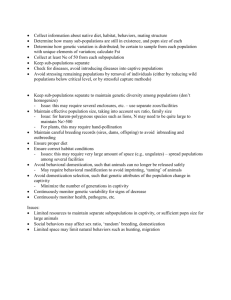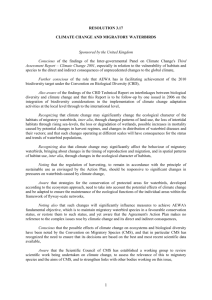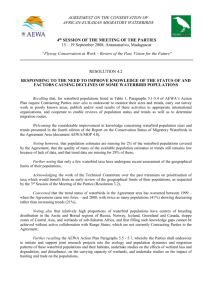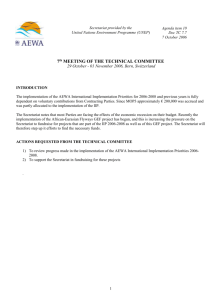GUIDANCE ON INTERPRETATION OF THE TERM `EXTREME
advertisement
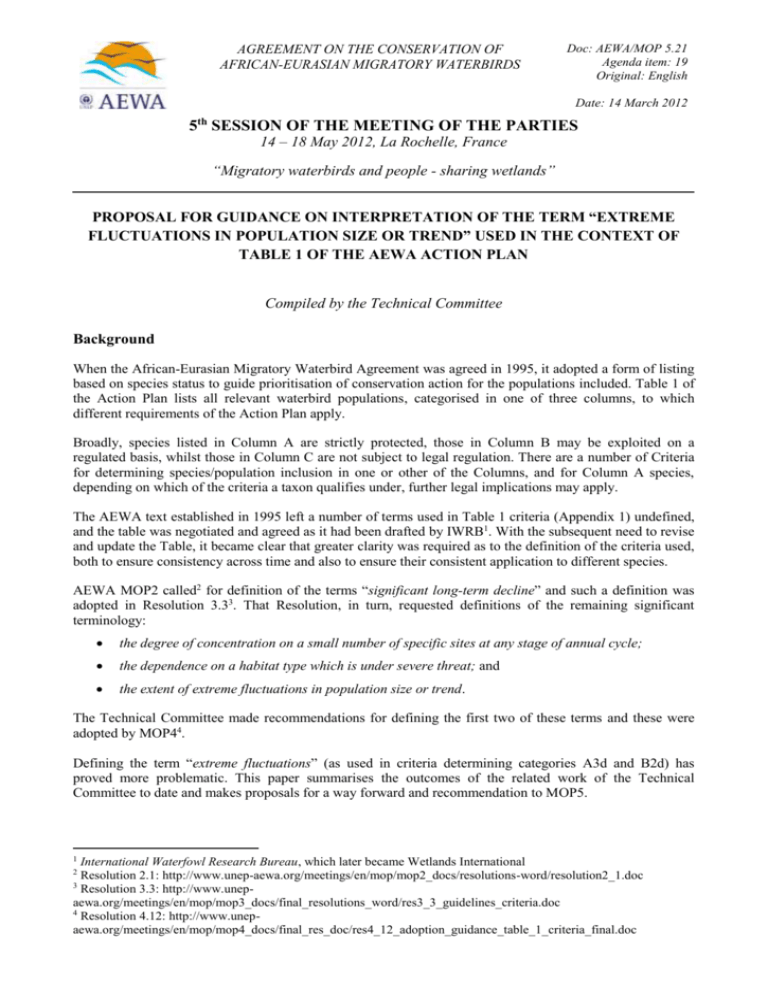
AGREEMENT ON THE CONSERVATION OF AFRICAN-EURASIAN MIGRATORY WATERBIRDS Doc: AEWA/MOP 5.21 Agenda item: 19 Original: English Date: 14 March 2012 5th SESSION OF THE MEETING OF THE PARTIES 14 – 18 May 2012, La Rochelle, France “Migratory waterbirds and people - sharing wetlands” PROPOSAL FOR GUIDANCE ON INTERPRETATION OF THE TERM “EXTREME FLUCTUATIONS IN POPULATION SIZE OR TREND” USED IN THE CONTEXT OF TABLE 1 OF THE AEWA ACTION PLAN Compiled by the Technical Committee Background When the African-Eurasian Migratory Waterbird Agreement was agreed in 1995, it adopted a form of listing based on species status to guide prioritisation of conservation action for the populations included. Table 1 of the Action Plan lists all relevant waterbird populations, categorised in one of three columns, to which different requirements of the Action Plan apply. Broadly, species listed in Column A are strictly protected, those in Column B may be exploited on a regulated basis, whilst those in Column C are not subject to legal regulation. There are a number of Criteria for determining species/population inclusion in one or other of the Columns, and for Column A species, depending on which of the criteria a taxon qualifies under, further legal implications may apply. The AEWA text established in 1995 left a number of terms used in Table 1 criteria (Appendix 1) undefined, and the table was negotiated and agreed as it had been drafted by IWRB1. With the subsequent need to revise and update the Table, it became clear that greater clarity was required as to the definition of the criteria used, both to ensure consistency across time and also to ensure their consistent application to different species. AEWA MOP2 called2 for definition of the terms “significant long-term decline” and such a definition was adopted in Resolution 3.33. That Resolution, in turn, requested definitions of the remaining significant terminology: the degree of concentration on a small number of specific sites at any stage of annual cycle; the dependence on a habitat type which is under severe threat; and the extent of extreme fluctuations in population size or trend. The Technical Committee made recommendations for defining the first two of these terms and these were adopted by MOP44. Defining the term “extreme fluctuations” (as used in criteria determining categories A3d and B2d) has proved more problematic. This paper summarises the outcomes of the related work of the Technical Committee to date and makes proposals for a way forward and recommendation to MOP5. 1 International Waterfowl Research Bureau, which later became Wetlands International Resolution 2.1: http://www.unep-aewa.org/meetings/en/mop/mop2_docs/resolutions-word/resolution2_1.doc 3 Resolution 3.3: http://www.unepaewa.org/meetings/en/mop/mop3_docs/final_resolutions_word/res3_3_guidelines_criteria.doc 4 Resolution 4.12: http://www.unepaewa.org/meetings/en/mop/mop4_docs/final_res_doc/res4_12_adoption_guidance_table_1_criteria_final.doc 2 Previous considerations The Technical Committee’s initial consideration was to use the IUCN Red List criterion for “extreme fluctuations” as guidance: “Extreme fluctuations could be said to occur in a number of taxa when population size or distribution area varies widely, rapidly and frequently, typically with a variation greater than one order of magnitude (i.e. a tenfold increase or decrease).”5 However, it became clear that (water)bird populations do not fluctuate in size at a scale of one order of magnitude. Subsequent discussion considered adjusting the definition so as to be more applicable for the purpose of assessing bird populations. In terms of application there are only three AEWA populations that are currently categorised as “Fluctuating”. The West Mediterranean/West African population of the Marbled Teal Marmaronetta angustirostris has been described as such on expert advice from Andy Green, while the fluctuating status of the European/African population of the Spotted Crake Porzana porzana, and the Black Sea/Mediterranean population of the Sandwich Tern Sterna sandvicensis is based on the BirdLife’s Birds in Europe 2 (2004), which compiled national breeding population estimates and trends. However, the extent to which these three species show abnormally large fluctuations is dubious. Francis & Stroud (2006, in prep.) reviewed information regarding Spotted Crakes in UK, including a major literature review, and could not find any evidence of fluctuation, although there are data showing some fluctuations of numbers of breeding pairs at a site in Denmark (Kjeldsen, 2008). With the construction of nesting platforms at Atanasovsko Lake in the late 1980s-early 1990s, the Bulgarian population of Sandwich Tern increased within a few years from ca. 10 breeding pairs to 1,269 pairs in 1994. It then declined and in 1996-2002 the breeding population numbered 178-501 pairs. With the construction of nesting platforms in 1998 at nearby-located Pomorie Lake, the numbers of the pairs there increased at the expense of those at Atanasovsko Lake. The overall numbers are highly dependent on the availability and state of artificial nesting platforms and the water levels in these two shallow coastal lagoons (Iankov, 2007). Tern species and some other colonially breeding waterbirds can demonstrate short-term variability in the use of multiple alternative colony locations. Unless census surveys are undertaken at all alternative breeding sites, changes in local numbers can suggest fluctuating populations although in reality the changes are rather the consequence of changing colony locations. In considering the issue further, however, there was concern about the implications of consequences of an AEWA re-definition of “extreme fluctuation” given that this would then be at variance to the already widely applied IUCN definition. Further discussion by the Technical Committee has suggested that the problem could be resolved by simply changing the wording of criterion from “extreme” to “large” fluctuation. This would avoid confusion with the IUCN Red List term and definition which is clearly inappropriate for waterbirds, and it would usefully avoid the scenario of two meanings for the same term in the context of species listings. A further Technical Committee conclusion was that such a criterion would probably only ever apply to a small number of populations and thus a pragmatic, qualitative solution should be sought that did not result in significant further expenditure of resources in developing any definition. 5 IUCN Red List Categories and Criteria: Version 3.1 2 Proposed recommendation for MOP5 The Technical Committee thus proposes a qualitative definition which identifies life-history attributes of those species where the criterion is likely to be applied. The following is suggested: “Large fluctuations can be said to occur where population size or distribution area varies widely, rapidly and frequently, typically with a variation greater than a factor of two (i.e., doubling or halving) within a short period of time (typically three years or one generation, whichever is longer).” Giving some quantitative guidance that includes magnitude of fluctuation and time-scale (absent from the IUCN definition, but arguably needed) seems helpful. The factor of two and timescale suggested are likely to pick out only the most extreme species/populations from knowledge of waterbird dynamics. References Francis, I.S. & Stroud, D.A. (2006). Spotted Crakes Porzana porzana breeding in the UK - a history and evaluation of current status. Waterbirds around the world. Eds. G.C. Boere, C.A. Galbraith & D.A. Stroud. The Stationery Office, Edinburgh, UK. Pp. 491-492. Francis, I.S. & Stroud, D.A. (in prep.). Spotted Crakes breeding in Britain and Ireland: a history and evaluation of current status. British Birds. Iankov, P. (ed.) (2007). Atlas of Breeding Birds in Bulgaria. Bulgarian Society for the Protection for Birds, Conservation Series, Book 10. Sofia, BSPB. Pp. 286-287. Kjeldsen, J.P. (2008). Ynglefugle i Vejlerne efter inddæmningen, med særlig vægt på feltstationsårene 1978-2003. Dansk Ornitologisk Forenings Tidsskrift 102(1): 1-240. 3 Appendix 1 Criteria for listings in Table 1 of AEWA’s Action Plan (as approved by MOP4 in 2008) Table 1 a/ STATUS OF THE POPULATIONS OF MIGRATORY WATERBIRDS KEY TO CLASSIFICATION The following key to Table 1 is a basis for implementation of the Action Plan: Column A Category 1: (a) Category 2: Populations numbering between around 10,000 and around 25,000 individuals. Category 3: Populations numbering between around 25,000 and around 100,000 individuals and considered to be at risk as a result of: Species, which are included in Appendix I to the Convention on the Conservation of Migratory species of Wild Animals; (b) Species, which are listed as threatened on the IUCN Red list of Threatened Species, as reported in the most recent summary by BirdLife International; or (c) Populations, which number less than around 10,000 individuals. (a) (b) (c) (d) Concentration onto a small number of sites at any stage of their annual cycle; Dependence on a habitat type, which is under severe threat; Showing significant long-term decline; or Showing extreme fluctuations in population size or trend. For species listed in categories 2 and 3 above, see paragraph 2.1.1 of the Action Plan contained in Annex 3 to the Agreement. Column B Category 1: Category 2: Populations numbering between around 25,000 and around 100,000 individuals and which do not fulfil the conditions in respect of column A, as described above. Populations numbering more than around 100,000 individuals and considered to be in need of special attention as a result of: (a) Concentration onto a small number of sites at any stage of their annual cycle; (b) Dependence on a habitat type, which is under severe threat; (c) Showing significant long-term decline; or (d) Showing extreme fluctuations in population size or trend. Column C Category 1: Populations numbering more than around 100,000 individuals which could significantly benefit from international cooperation and which do not fulfil the conditions in respect of either column A or column B, above. Table 1, “Status of the populations of migratory waterbirds” forms part of the Action Plan contained in Annex 3 to the Agreement. a/ 4


